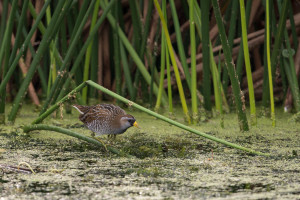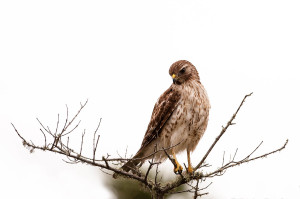The second stop on our whirlwind Florida tour was Viera Wetlands. Actually, the formal name is the Ritch Grissom Memorial Wetlands at Viera. Yes, it’s one of Brevard county’s water treatment facilities but, it’s also one of the finest birding spots you’ll ever visit. It consists of about 200 acres divided into four ponds plus a central lake. The primary purpose of the facility is to treat water to a point where it can be used for irrigation or simply released back into the environment. That being said, Brevard county has gone to great lengths to make it friendly for birds, birders and photographers. Several native plant species have been placed here to create a rich and varied environment for lots of different birds. Gravel roads on the top of the dikes dividing the ponds make Viera Wetlands easily accessible by car or on foot. About half of the dikes were open to foot traffic only when we were there.
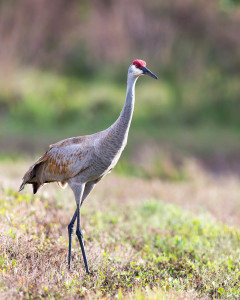 We didn’t see a lot of any particular species of bird but, we saw a surprising number of different species. Almost immediately after entering the compound we were greeted by a couple of Sandhill Cranes strolling around like they owned the place. These large nearly four foot tall birds are known to travel from Wisconsin and further north down to Florida for the winter. I was a bit surprised to see them at Viera but, I now understand that they are often seen there. Sandhills are the only species of crane in the world that are not endangered.
We didn’t see a lot of any particular species of bird but, we saw a surprising number of different species. Almost immediately after entering the compound we were greeted by a couple of Sandhill Cranes strolling around like they owned the place. These large nearly four foot tall birds are known to travel from Wisconsin and further north down to Florida for the winter. I was a bit surprised to see them at Viera but, I now understand that they are often seen there. Sandhills are the only species of crane in the world that are not endangered.
We spoke with a very nice gentleman who lives nearby and frequently visits here. He showed us a couple of birds that are almost impossible to spot. The Sora is a member of the rail family and so small and secretive that you would never know he was there. They live in the reeds and cattails, move slowly, deliberately and mostly stay in the shadows. Getting a decent photograph of one of these little guys is a real challenge.
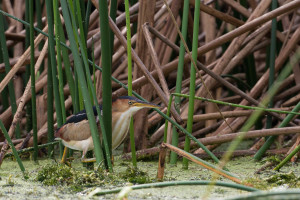 Only a few feet from the Sora was another bird that is relatively common but, nearly impossible to spot. This is a Least Bittern. It’s a tiny member of the heron family and has camouflage in addition to the Sora’s tools to help hide it from sight.
Only a few feet from the Sora was another bird that is relatively common but, nearly impossible to spot. This is a Least Bittern. It’s a tiny member of the heron family and has camouflage in addition to the Sora’s tools to help hide it from sight.
I had never seen nor photographed either of these birds before and only did it this time because they were brought to my attention. I could have been there all day and never noticed either one. Pretty cool!
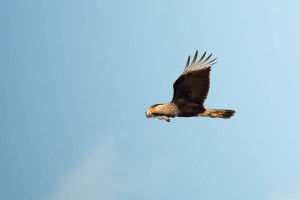 Overhead I spotted a large bird flying across the compound. I raised my camera and fired off a few frames as it passed by. To my delight it was a Crested Caracara. One of the birds on my “wish list”. They’re a member of the falcon family but, they act more like vultures. This particular one has some nesting material in his mouth. I never saw where the nest was located. This photograph was taken from a long distance and heavily cropped. Unfortunately, I didn’t see another Caracara the rest of our trip. Oh well, there’s always next time.
Overhead I spotted a large bird flying across the compound. I raised my camera and fired off a few frames as it passed by. To my delight it was a Crested Caracara. One of the birds on my “wish list”. They’re a member of the falcon family but, they act more like vultures. This particular one has some nesting material in his mouth. I never saw where the nest was located. This photograph was taken from a long distance and heavily cropped. Unfortunately, I didn’t see another Caracara the rest of our trip. Oh well, there’s always next time.
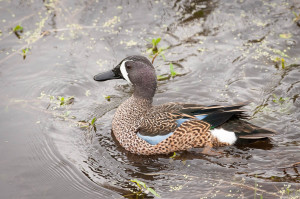 The ditches along some of the roads allow you to get pretty close to the birds as long as you shoot from the car. The downside is that you end up shooting down on the bird so it’s not the best angle. I decided to include this image because this Blue-winged Teal is actually showing his signature blue wings. Normally, you can’t see the blue unless they are in flight. Although they range from Canada to the northern tip of South America, I had never seen one in the wild before. Got to get out more I suppose!
The ditches along some of the roads allow you to get pretty close to the birds as long as you shoot from the car. The downside is that you end up shooting down on the bird so it’s not the best angle. I decided to include this image because this Blue-winged Teal is actually showing his signature blue wings. Normally, you can’t see the blue unless they are in flight. Although they range from Canada to the northern tip of South America, I had never seen one in the wild before. Got to get out more I suppose!
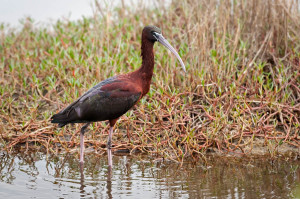 Not too far away from the teal I spotted one of the most beautiful Glossy Ibis that I’ve ever seen. These medium sized wading birds primarily live along the US Atlantic Coast. Most I’ve seen were kind of dark and drab but, this one was in good light and had some snap. He was decked out in his full breeding plumage.
Not too far away from the teal I spotted one of the most beautiful Glossy Ibis that I’ve ever seen. These medium sized wading birds primarily live along the US Atlantic Coast. Most I’ve seen were kind of dark and drab but, this one was in good light and had some snap. He was decked out in his full breeding plumage.
Intermittent thunderstorms were in the area during our day at Viera so the light conditions were variable. While the light was fantastic when I took the Ibis image, things were quite different when this hawk landed in a tree down the road. Somehow, I just can’t resist shooting raptors. They are such interesting birds. We also saw a Bald Eagle and an Osprey but, they were too far away and my images of them are marginal.
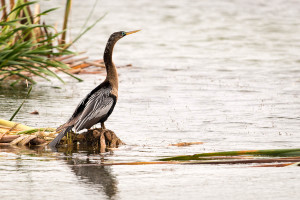 Several Anhingas were in the ponds.Their beautiful and contrasty wings have amazing silvery patterns offset by their black feathers. This one appears to be in breeding plumage because his neck is a rich brown color. Anhingas have no oils in their feathers so they can easily dive underwater for food. When they swim on the surface only their neck and head is seen above water. That’s why they have been nick-named the “snake bird”. They cannot fly after swimming until they’ve dried their wings in the sunlight.
Several Anhingas were in the ponds.Their beautiful and contrasty wings have amazing silvery patterns offset by their black feathers. This one appears to be in breeding plumage because his neck is a rich brown color. Anhingas have no oils in their feathers so they can easily dive underwater for food. When they swim on the surface only their neck and head is seen above water. That’s why they have been nick-named the “snake bird”. They cannot fly after swimming until they’ve dried their wings in the sunlight.
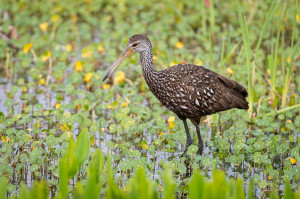 Across the dike from where we saw the Sora and Least Bittern we spotted another unusual bird that I had never seen before. It’s a Limpkin. We initially thought it was a rail. They are in the same order but, a different family. Florida is as far north as these birds roam.
Across the dike from where we saw the Sora and Least Bittern we spotted another unusual bird that I had never seen before. It’s a Limpkin. We initially thought it was a rail. They are in the same order but, a different family. Florida is as far north as these birds roam.
While we were wandering around Viera marveling at the wildlife this guy drives up beside us. He rolls down his window and says “Psst…wanna see a Kestrel?” Naturally, I said “who wouldn’t!”. It seemed pretty weird but, he told us about a second group of ponds across the highway from Viera and down a dirt road. He said the Kestrel will be at the end of the dirt road on a fence post near the parking area at 10 am.
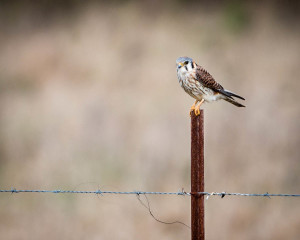 As far-fetched as the whole story sounds we decided to see just how punctual these Florida Kestrels actually are. Down the dirt road we went to Dan Click Ponds. To our utter disbelief, we got there and sure enough…there was the Kestrel! There was absolutely no way that this little falcon was going to let us get anywhere near him but, he was certainly there flying from fence post to fence post. I took this photograph just to prove he was there.
As far-fetched as the whole story sounds we decided to see just how punctual these Florida Kestrels actually are. Down the dirt road we went to Dan Click Ponds. To our utter disbelief, we got there and sure enough…there was the Kestrel! There was absolutely no way that this little falcon was going to let us get anywhere near him but, he was certainly there flying from fence post to fence post. I took this photograph just to prove he was there.
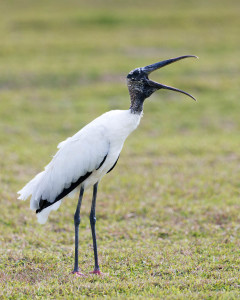 As we were leaving the Viera Wetlands compound we spotted one last interesting bird out in a field. This is a Wood Stork. It’s the only stork that breeds in the US and is considered endangered from North Carolina down to Florida although it is not endangered in South America. It’s a strange creature with a head and bill that looks prehistoric. Pretty much all storks worldwide are under pressure and most varieties are endangered. I never turn down an opportunity to photograph a rare or somewhat rare bird.
As we were leaving the Viera Wetlands compound we spotted one last interesting bird out in a field. This is a Wood Stork. It’s the only stork that breeds in the US and is considered endangered from North Carolina down to Florida although it is not endangered in South America. It’s a strange creature with a head and bill that looks prehistoric. Pretty much all storks worldwide are under pressure and most varieties are endangered. I never turn down an opportunity to photograph a rare or somewhat rare bird.
Viera Wetlands was very much a worthwhile place to visit. Great diversity and good access to wildlife. I really wish that more municipalities would take Brevard County’s example and allow access to water treatment wetlands like this. They have created a birding hotspot that’s attractive to tourists while still cleaning the water and giving back to the environment. Ecotourism I suppose.
Well, there’s more to come from Florida. Stay tuned!

